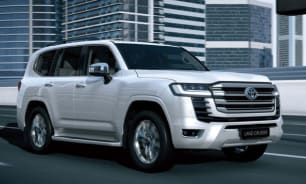Quiet, comfortable, and easy to spend big days in the driver's seat or as a passenger.
Steering is light and responsive and, with a 11.8m turning circle, this 4WD wagon still feels highly manoeuvrable.
The V6 offers up so much power and torque – and it's all managed so smoothly through the 10-speed auto – that the Cruiser is able to go from standing start to punching along the road at a decent clip, or transition from open-road cruising to safe overtaking without any lag of note.
Ride and handling are well sorted but this is a Cruiser after all so ultimately it tends towards being soft and comfortable, rather than dynamic.
Its suspension – double wishbone, independent at the front and live axle and multi-links at the rear with coils all-around – manages to soak up most imperfections in the road surface.
The 300 Series' brakes – ventilated discs all-around – brought the big Cruiser to a controlled stop during two of my patented 'Watch out for that bloody roo!' set-pieces.
In terms of on-road ride, handling and performance, the 300 Series impresses. But how does it perform off-road?
First things first: the Sahara-spec LandCruiser does miss out on some of the handy 4WD gear that the two higher grades (Sahara ZX and GR Sport) get, namely Toyota's swaybar-disconnect equivalent electronic-'Kinetic Dynamic Suspension System' (included onboard the GR Sport), front and rear differential locks (GR Sport), adaptive variable suspension (Sahara ZX and GR Sport) and a rear torque-sensing limited-slip differential (ZX).
But in the grand scheme of things that shouldn't impede you too much, if at all, unless you're really going all-out to break your Cruiser while 4WDing.
We managed all obstacles at our testing ground without any strife.
A few years back when Toyota announced it would replace the V8 with the V6 there was quite a lot of concern voiced over the change. Let's be frank here: there was a hell of a lot of whinging.
But people needn't have worried because though the V8 was a bloody good engine the V6 produces more power and more torque than it does (up 27kW and 50Nm).
And that power and torque is consistently delivered across a nice spread of revs.
In combination with the 10-speed auto it's a smooth-as pairing. That auto is very clever – smarter than you and me – because it's never hunting through ratios to try and find the sweet spot, it's always bang-on.
High- and low-range gearing are solid in the 300 Series, and the Cruiser has a 50:50 centre diff lock.
And, on top of all that, you also have access to a comprehensive suite of driver assist tech aimed at making your driving life off-road easier and safer.
The traction control system has been really well calibrated – fine tuned, very precise and seamless in its application.
The 300's multi-terrain select system gives you the option of cycling through driving modes such as 'Sand', 'Mud' and 'Rock' to suit the terrain you're on.
In action, those modes adjust vehicle systems, throttle, engine output, etc to give you the best chance possible of getting through every obstacle safely and in a controlled fashion.
Off-road measurements and angles are decent: ground clearance is 235mm, wading depth is 700mm, and approach, ramp-over and departure angles are 32, 21, and 25 degrees, respectively.
So, all in all, in terms of measurements that are suited to hardcore low-range four wheel driving, the LandCruiser 300 Series ticks all the boxes.
And while there's no denying the 300 Series is a big unit, it feels pretty nimble in the bush, even on tight tracks or pinched approaches to hills or creek crossings.
As well as a dialled-in off-road traction control system and all of those driving modes, it has handy tech such as crawl control, which works like a low-speed cruise control.
So, the only flaw in the 300 Series off-road set-up is its tyres, as its standard Bridgestone Dueler all-terrains (265/65 R18) are better suited to dry-track 4WDing in good weather than taking on any difficult stuff.
In terms of towing capacity, the 300 Series can legally tow a 750kg unbraked trailer, and 3500kg braked.































